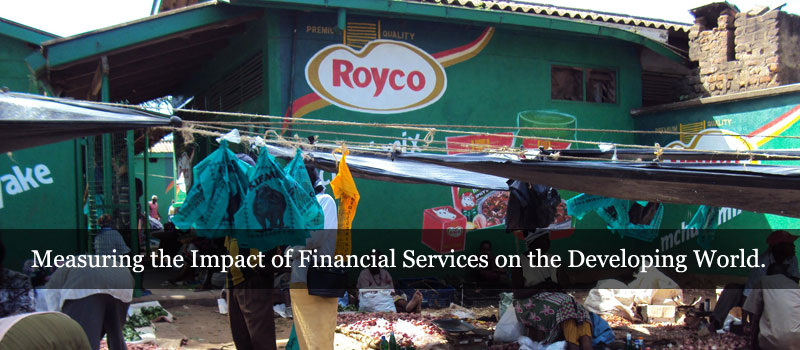Research Methods
Research Design: The project's research design emphasizes the entire causal pathway to impact. This assessment uses qualitative and quantitative methods to explore not only whether impacts occur, but how and why they occur. Specifically, it looks at how people use financial services and how such use affects the impact on clients, households, and enterprises. The assessment covers a wide variety of innovations, countries, and levels of analysis.
The project features a mixed-methods approach, employing qualitative and quantitative methods with experimental, quasi-experimental, and non-experimental designs. The method selection and sampling design are based on field conditions, including the financial service provider's business model. The research methods work in complementary relationships to deliver a profound understanding of the effects of financial services.
Below is a brief description of each research tool currently in use or under design:
I. FSA Study Methods/Framework
Deep Dive: Deep dive methodology is a framework combining quantitative and qualitative methods and tools to elicit in-depth information from the same subject. It can be considered as a series of data gathering efforts from the same subject where we tailor queries (quantitative and qualitative) to gather in-depth insights to know how they behave and explain why they behave that way. The methodology can also be applied for a randomized control trial (RCT) sample, or a non-random sample.
Enabling Environment Framework: Helps examine external variables that affect the outcomes of grantee microfinance activities. Includes such influences as specific governance and cultural factors directly affecting the innovation, as well as political stability, macroeconomic policies, and governance quality.
Randomized Encouragement Trial (RET): The design, instead of randomizing the innovation/treatment across the population, encourages behaviors related to adopting/using the innovation or adhering to the treatment. Here, the entire study population is exposed to the same (or similar) treatment/innovation, but some segments are encouraged to take the innovation or adhere to the treatment. So, the basic difference between the treatment and control groups is the difference in the level of encouragement. In our study, encouragement is provided through intense information/marketing campaign only in selected areas of the study locations for a period of 18 months. The design helps address two main questions: First, to examine whether participation in the program or adherence to treatment could be affected by access to information and motivation such that the technique could be employed as a cost-efficient mechanism to improve outreach and impact of the innovation. Second, to test the causal effects of the innovation/treatment when there is uneven adherence or take up of the innovation. If an encouragement strategy increases overall adherence or participation in the program, then we would expect that the response of that group relative to that with low encouragement could be attributed to the treatment/innovative program.
II. FSA Study Tools
Case studies: In our study, this involves an in-depth investigation of a single individual or an event to explore association and some causal links with an innovation. We include primarily open-ended and some closed-ended questions to gather case history, perceptions, aspirations and some quantitative data.
Financial Diaries: We conduct weekly surveys using a structured questionnaire to record household transactions for a period of 1-2 years. The diaries track what households earn, spend, save, and borrow, to capture critical weekly dynamics of transaction patterns after the introduction of an innovation. As a result, we are able to track the causal chain linking the innovation to potential outcomes through both aggregate data analysis, as well as qualitative case studies.
Focus Group Discussions (FGDs) and Participatory Rapid Appraisals (PRAs): A qualitative tool that helps gather information from a group via a moderator who guides the discussion or activity. In our research, FGDs and PRAs are used in conducting landscape studies to document the range of financial service options in the service area and to offer insights into the value proposition of the innovation. They are also used to evaluate outcomes/effects of an innovation and in examining the enabling environment.
Key Informant Interviews (KIIs): Primarily a qualitative tool, it helps gather information from people or institutions that are particularly knowledgeable about a community or situation. Usually involves semi-structured interviews with primarily open-ended and some closed-ended questions. In our research, they are used in conducting landscape studies to document the range of financial service options in the service area and to offer insights into the value proposition of the innovation. They are also used to evaluate outcomes of an innovation and in examining the enabling environment. They are also used to examine product use to understand how financial service clients use a particular innovation in the management of households and/or businesses, suggesting likely impacts of innovation in risk management and consumption smoothing.
Quantitative Long Survey: Uses structured surveys with primarily closed ended questions to collect quantitative data. The tool helps measure the depth of outreach (does product/service reach the poor/ultra-poor?) of the institution using the innovative product as in the case of Welfare Assessment Survey using Poverty Assessment Tool - PAT, measure the use and effects of financial services as in impact surveys.
Quantitative Mini-Survey: These are short surveys using a structured format with primarily close ended questions to collect basic information to help understand the profile of the population. In our study, such surveys are used to collect demographic details and some program participation details of the respondents in FGDs and to compare them to community characteristics to ensure representativeness of our sample and validity of findings. Also, used to conduct short surveys with market vendors to understand the profile of their clients and their use of the innovative product examined in the study.




